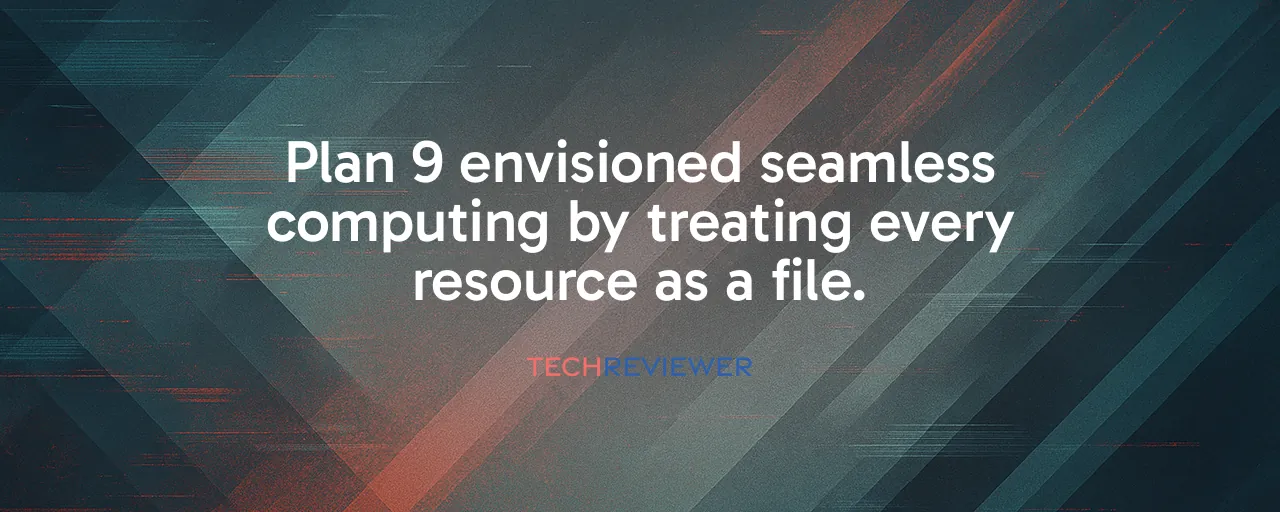A Blueprint for a Connected World
In the mid-1980s, Bell Labs researchers, fresh from creating Unix and C, dreamed up Plan 9. They wanted an operating system that could weave computers, networks, and resources into a seamless whole. Their answer was radical: make everything a file. Need to connect to a remote server? Open a file. Want to control a network interface? Write to a file. The 9P protocol made this possible, letting devices and programs communicate as if they were local, no matter where they sat on the network. It was a vision of computing without borders, built for a future of interconnected devices.
Plan 9 didn't just rethink file systems. It introduced per-process namespaces, letting each program see only the resources it needed, a concept that foreshadowed today's container technology. Features like mouse chording for text editing and the Plumber utility, which triggered commands based on text patterns, showed a flair for creative interfaces. Even UTF-8, now the universal standard for text encoding, was born here. These ideas were elegant, forward-thinking, and, in many ways, decades ahead of their time.
Why Simplicity Failed to Win
Despite its brilliance, Plan 9 stumbled. Its file-centric approach, while elegant, came with trade-offs. Network operations like streaming music often lagged due to 9P's lack of buffering, making it slower than specialized protocols. Users reported stuttering MP3 playback over 9P, a frustration that smoother systems avoided. The system's deliberate break from Unix compatibility meant developers had to rewrite everything from scratch, a daunting task when Linux offered a familiar, free alternative.
Timing hurt, too. Plan 9 launched in 1992, when personal computers were booming and centralized systems, which Plan 9 leaned into, felt outdated. By the time it went open source in 2000, Linux had already captured the open source community's heart. Bell Labs' parent, AT&T, faced financial turmoil after its 1984 breakup, slashing the research budget that fueled Plan 9. Marketing missteps didn't help; positioned as a research project, it never gained the commercial push needed to compete in the dot-com era.
Lessons From Forgotten Innovators
Plan 9's story isn't unique. Google Wave, launched in 2009, promised real-time collaboration but sank under its own complexity and unclear purpose, abandoned after just 16 months. Palm webOS, with its slick multitasking and intuitive interface, dazzled users in 2009 but couldn't compete with Apple and Google's app ecosystems, fading by 2011. Both shared Plan 9's fate: brilliant ideas undone by poor timing, weak ecosystems, and entrenched competitors.
These cases reveal hard truths. Innovation alone doesn't guarantee success; market readiness and user familiarity matter just as much. Plan 9's small developer community couldn't match Linux's driver support or app ecosystem, just as webOS lacked the apps to rival iOS. Google Wave confused users who didn't grasp its purpose, much like Plan 9's steep learning curve alienated Unix veterans. The lesson? Even the best ideas need a clear path to users' hands and a robust support system to thrive.
Echoes in Today's Tech
Plan 9 may have faded, but its fingerprints are everywhere. The 9front fork, actively maintained with monthly updates, supports modern hardware like WiFi and USB, keeping the system alive for enthusiasts and researchers. Concepts like per-process namespaces power Docker and Kubernetes, simplifying how we isolate and manage applications today. The Go programming language, built by Plan 9 alumni at Google, carries forward its lightweight threading model with goroutines. Even the Linux kernel adopted 9P support, letting modern systems tap into Plan 9's resource-sharing model.
As cloud computing, IoT, and edge devices create complex, distributed networks, Plan 9's ideas feel more relevant than ever. Its vision of seamless resource access across devices prefigures the challenges of coordinating microservices or IoT fleets. Researchers still study 9P, proposing tweaks like streaming extensions to boost performance. While Plan 9 itself won't replace Windows or Linux, its elegant solutions continue to inspire those tackling tomorrow's computing puzzles.
What Plan 9 Teaches Us Now
Plan 9's rise and fall show that technical brilliance needs more than good ideas to succeed. It demands timing, ecosystems, and a willingness to meet users where they are. Yet its legacy endures in the tools we use daily, from UTF-8 to containerized apps. Comparing it to Google Wave and Palm webOS highlights a universal challenge: building a platform requires not just vision but relentless execution and a bit of luck. For developers and researchers, Plan 9 remains a masterclass in elegant design, a reminder that today's failures can seed tomorrow's breakthroughs.
The system's story also prompts reflection. As computing grows more distributed, with devices from phones to sensors needing to work as one, Plan 9's file-based approach offers a model worth revisiting. Its small but dedicated community, through projects like 9front, keeps the flame alive, proving that even a forgotten system can still teach us how to build a more connected world.
